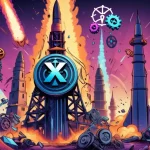Ethereum Breaks 2021 Highs as Whales Hoard AAVE and Layer Brett Sparks Meme Coin Frenzy

Ethereum Shatters 2021 Highs as Whales Stack AAVE and Layer Brett Fuels Meme Coin Madness
Ethereum has powered through its 2021 price peak, sending a surge of excitement through the crypto market and reinforcing its status as the linchpin of decentralized innovation. While ETH steals the show, heavyweight investors—known as whales—are making calculated moves in AAVE, a DeFi stalwart, alongside speculative frenzy around Layer Brett ($LBRETT), a fresh meme coin on Ethereum’s Layer 2. This trifecta paints a vivid picture of the market’s split personality: utility, stability, and downright gambling.
- Ethereum’s Surge: ETH breaks past 2021 highs with tech upgrades and demand as key drivers.
- AAVE Attraction: Whales accumulate this DeFi lending protocol, betting on long-term growth.
- Layer Brett Buzz: A meme coin on Layer 2 sparks hype, but screams high risk.
Ethereum’s Record-Breaking Rally: What’s Fueling the Fire?
Ethereum’s latest price breakthrough isn’t just a number on a chart—it’s a loud statement about its unshakable role in the decentralized world. As the foundation of Web3, Ethereum powers everything from decentralized finance (DeFi) protocols to non-fungible token (NFT) marketplaces and a vast array of tokens built on its ERC-20 standard. For the uninitiated, DeFi means financial services—think lending or trading—run by code on the blockchain, no banks required. Ethereum hosts over 70% of the total value locked in these protocols, a clear sign of its dominance, even if exact figures shift by the hour. Both institutional players like hedge funds and retail investors are piling in, driven by ETH’s promise as a programmable money platform.
A massive catalyst behind this rally is Ethereum’s ongoing mission to fix its notorious pain points: crippling transaction fees, dubbed “gas,” and slower processing times compared to newer chains. This is where Layer 2 solutions come in—think of them as side roads built alongside Ethereum’s main highway (Layer 1). They handle transactions faster and cheaper while still relying on Ethereum’s core security. Projects like Optimism and Arbitrum are slashing costs by up to 90% in many cases, with Arbitrum alone boasting millions of unique user addresses. Then there’s zkSync, using zero-knowledge proofs to bundle thousands of transactions into a single, efficient package. These aren’t just tech buzzwords—they make Ethereum usable for developers building decentralized apps (dApps) and for regular folks who don’t want to pay $50 for a simple token swap. Analysts are throwing around price targets as high as $8,000 if this momentum sticks, rooted in real metrics like developer activity—Ethereum still outpaces rivals in active coders—and growing real-world adoption, as discussed in recent market analysis.
But let’s not get carried away with the hype. Ethereum’s path isn’t all roses. Volatility is a constant shadow in crypto, with sudden 20% drops often triggered by market jitters or broader economic pressures like interest rate hikes. Competition is fierce too—layer-1 blockchains like Solana and Avalanche offer similar scalability at a lower cost, tempting developers frustrated with Ethereum’s complexity. Even after its 2022 shift to proof-of-stake via “The Merge,” which slashed energy use, critics still drag up its past mining footprint as a reputational stain. And then there’s the regulatory beast: Ethereum’s central role in DeFi and NFTs makes it a juicy target for government oversight, which could choke innovation if policies turn hostile. As Bitcoin maximalists, we tip our hats to Ethereum’s smart contract game—something BTC doesn’t mess with and arguably shouldn’t. Bitcoin is the ultimate hard money, a fortress against centralized meddling. But Ethereum’s ecosystem is carving out a complementary space, even if we occasionally roll our eyes at the altcoin circus.
AAVE Whale Activity: DeFi’s Steady Anchor
As Ethereum’s infrastructure lays the groundwork for DeFi’s explosion, big-time investors are stacking AAVE, one of the sector’s heavy hitters. For those new to the term, whales are crypto investors with massive holdings, often capable of nudging market trends with a single trade. AAVE is a decentralized lending protocol, essentially a bank without bankers, where users can lend or borrow crypto directly via smart contracts. It’s been a DeFi cornerstone since the 2020 boom, offering slick features like flash loans—imagine borrowing millions for a split-second trade with no collateral, repaying it instantly, a high-stakes tool for pros. AAVE also boasts improved governance, letting token holders vote on upgrades, and multi-chain support to operate across various blockchains.
On-chain data from platforms like Glassnode shows large wallets accumulating AAVE, a strong hint these whales aren’t just flipping for quick gains but banking on its future, as highlighted in recent community discussions. Why the faith? With crypto markets heating up, borrowing demand often spikes as traders leverage positions, and AAVE is primed to profit. Rumors of an “Umbrella” upgrade are circulating, potentially tied to better risk management or seamless cross-chain bridges, though concrete details are thin. If true, it could solidify AAVE’s edge in a crowded DeFi field. This isn’t speculative fluff—AAVE represents the practical, utility-driven side of crypto, a counterweight to the wilder bets out there, with some pondering its future potential in DeFi. But let’s keep our feet on the ground: DeFi isn’t bulletproof. High-profile hacks have bled millions from protocols in the past, and AAVE isn’t immune. Regulatory clouds are thickening too—global lawmakers are eyeing DeFi with suspicion, and a harsh crackdown could stall even the most solid players. Whales might be confident, but they’re not clairvoyant.
Layer Brett: Meme Coin Mania on Layer 2
On the flip side of Ethereum’s serious tech lies Layer Brett ($LBRETT), a newborn meme coin stirring up a storm among the hype chasers. Built on Ethereum’s Layer 2, it reaps the benefits of faster transactions and lower fees compared to the main chain, a technical edge over older meme coins like Dogecoin or Shiba Inu. If you’re scratching your head, meme coins are tokens fueled by internet culture and community excitement rather than deep utility—often skyrocketing on pure FOMO before crashing just as hard. Layer Brett tries to stand apart with a fixed supply of 10 billion tokens, a buzzing presale phase, high staking rewards to encourage holding, and ambitious plans for NFT tie-ins, gamified features, and cross-chain capabilities later on, as covered in recent updates.
Let’s cut through the noise: Layer Brett is the kind of nonsense that makes crypto skeptics cackle. It’s hype over substance, a lottery ticket with no guarantee of a payout. Sure, the Layer 2 hook is neat, and staking rewards might keep some bagholders loyal, but without a proven track record or transparent developer team—details remain murky—it’s a fast track to zero if the community bails. Meme coin history is a graveyard of forgotten tokens; for every Dogecoin that sticks, dozens vanish into obscurity. Investors jumping in should brace for a wild ride and keep their rent money far away, especially considering the risks and rewards of meme coins like Layer Brett. This is speculative mania at its peak, a stark reminder of crypto’s schizophrenic nature during bull runs like Ethereum’s current wave.
The Bigger Picture: Crypto’s Split Personality
Stepping back, Ethereum, AAVE, and Layer Brett showcase the fractured soul of the crypto market. Ethereum and AAVE lean toward stability and purpose—projects with tangible use cases, proven technology, and measurable adoption. Layer Brett, meanwhile, embodies the reckless fever that grips this space, where fear of missing out can turn a niche token into a moonshot overnight, only to crater just as fast. This mix is what makes crypto both electrifying and infuriating. Ethereum’s rally may be lifting all boats, but some are barely seaworthy, a trend explored in-depth in analyses of Ethereum’s price surge and whale activity. And let’s not dodge the looming threat: regulation. Governments are sharpening their focus on DeFi protocols and meme coin presales alike, and a heavy-handed policy could rattle even the strongest contenders. For now, the vibe is bullish, but blind optimism is a rookie mistake.
From a Bitcoin maximalist lens, we can’t help but smirk at the altcoin drama. Bitcoin remains the unassailable store of value, the true middle finger to centralized control. Yet, Ethereum’s ecosystem fills gaps BTC doesn’t touch—smart contracts, dApps, and tokenized experiments—proving there’s room for parallel disruption. AAVE’s utility in DeFi hints at a financial future untethered from legacy systems, while Layer Brett reminds us why skepticism is survival in this game. The market’s diversity is its strength and its chaos, a messy push against the status quo that we’re hell-bent on championing, flaws and all, as underscored by insights into Ethereum’s surge beyond 2021 highs.
Key Questions and Takeaways
- What’s powering Ethereum’s push past 2021 highs?
A mix of soaring institutional and retail demand, plus Layer 2 upgrades like Optimism and Arbitrum that slash fees and boost transaction speeds, are driving ETH’s breakout. - Why are whales betting big on AAVE?
AAVE’s proven role in decentralized lending, potential upgrades like “Umbrella” for better functionality, and rising borrowing demand in a hot market make it a solid long-term play for deep-pocketed investors. - Is Layer Brett just another doomed meme coin?
Possibly—it’s too early to call. Its Layer 2 perks and staking rewards are interesting, but unproven value and meme coin volatility mark it as a high-stakes gamble. - Can Ethereum keep this rally going?
Fundamentals like adoption and tech progress point to yes, with targets like $8,000 floated, but competition from chains like Solana and regulatory risks could throw a wrench in the gears. - What do these projects say about the crypto market?
They reflect a spectrum of risk and reward—Ethereum and AAVE offer practical value and relative stability, while Layer Brett captures speculative chaos, mirroring diverse investor mindsets in a bullish phase.



